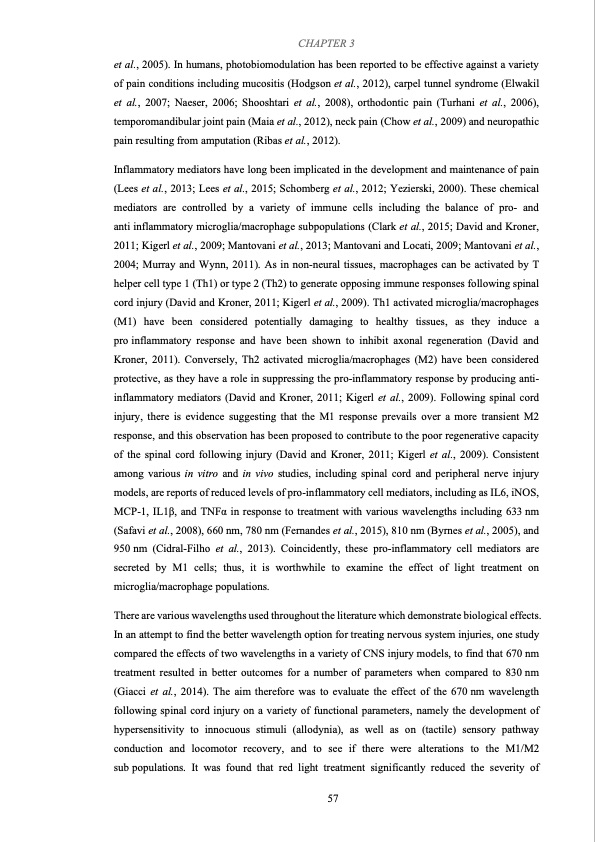
PDF Publication Title:
Text from PDF Page: 071
CHAPTER 3 et al., 2005). In humans, photobiomodulation has been reported to be effective against a variety of pain conditions including mucositis (Hodgson et al., 2012), carpel tunnel syndrome (Elwakil et al., 2007; Naeser, 2006; Shooshtari et al., 2008), orthodontic pain (Turhani et al., 2006), temporomandibular joint pain (Maia et al., 2012), neck pain (Chow et al., 2009) and neuropathic pain resulting from amputation (Ribas et al., 2012). Inflammatory mediators have long been implicated in the development and maintenance of pain (Lees et al., 2013; Lees et al., 2015; Schomberg et al., 2012; Yezierski, 2000). These chemical mediators are controlled by a variety of immune cells including the balance of pro- and anti inflammatory microglia/macrophage subpopulations (Clark et al., 2015; David and Kroner, 2011; Kigerl et al., 2009; Mantovani et al., 2013; Mantovani and Locati, 2009; Mantovani et al., 2004; Murray and Wynn, 2011). As in non-neural tissues, macrophages can be activated by T helper cell type 1 (Th1) or type 2 (Th2) to generate opposing immune responses following spinal cord injury (David and Kroner, 2011; Kigerl et al., 2009). Th1 activated microglia/macrophages (M1) have been considered potentially damaging to healthy tissues, as they induce a pro inflammatory response and have been shown to inhibit axonal regeneration (David and Kroner, 2011). Conversely, Th2 activated microglia/macrophages (M2) have been considered protective, as they have a role in suppressing the pro-inflammatory response by producing anti- inflammatory mediators (David and Kroner, 2011; Kigerl et al., 2009). Following spinal cord injury, there is evidence suggesting that the M1 response prevails over a more transient M2 response, and this observation has been proposed to contribute to the poor regenerative capacity of the spinal cord following injury (David and Kroner, 2011; Kigerl et al., 2009). Consistent among various in vitro and in vivo studies, including spinal cord and peripheral nerve injury models, are reports of reduced levels of pro-inflammatory cell mediators, including as IL6, iNOS, MCP-1, IL1β, and TNFα in response to treatment with various wavelengths including 633 nm (Safavi et al., 2008), 660 nm, 780 nm (Fernandes et al., 2015), 810 nm (Byrnes et al., 2005), and 950 nm (Cidral-Filho et al., 2013). Coincidently, these pro-inflammatory cell mediators are secreted by M1 cells; thus, it is worthwhile to examine the effect of light treatment on microglia/macrophage populations. There are various wavelengths used throughout the literature which demonstrate biological effects. In an attempt to find the better wavelength option for treating nervous system injuries, one study compared the effects of two wavelengths in a variety of CNS injury models, to find that 670 nm treatment resulted in better outcomes for a number of parameters when compared to 830 nm (Giacci et al., 2014). The aim therefore was to evaluate the effect of the 670 nm wavelength following spinal cord injury on a variety of functional parameters, namely the development of hypersensitivity to innocuous stimuli (allodynia), as well as on (tactile) sensory pathway conduction and locomotor recovery, and to see if there were alterations to the M1/M2 sub populations. It was found that red light treatment significantly reduced the severity of 57PDF Image | Effects of Red Light Treatment on Spinal Cord Injury

PDF Search Title:
Effects of Red Light Treatment on Spinal Cord InjuryOriginal File Name Searched:
Thesis_Di Hu_final.pdfDIY PDF Search: Google It | Yahoo | Bing
Cruise Ship Reviews | Luxury Resort | Jet | Yacht | and Travel Tech More Info
Cruising Review Topics and Articles More Info
Software based on Filemaker for the travel industry More Info
The Burgenstock Resort: Reviews on CruisingReview website... More Info
Resort Reviews: World Class resorts... More Info
The Riffelalp Resort: Reviews on CruisingReview website... More Info
| CONTACT TEL: 608-238-6001 Email: greg@cruisingreview.com | RSS | AMP |